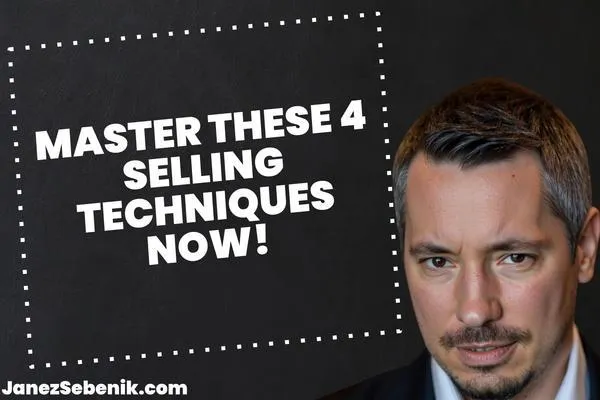
What Are the 4 Types of Selling Techniques?
Want to boost your sales game? Let's talk about the four main selling techniques. These are the secret weapons that top sellers use to close deals like pros.
The four types of selling techniques are solution selling, consultative selling, transactional selling, and provocative selling. Each has its own strengths and best-use scenarios. Knowing when to use which can make or break your sales performance.
Ready to level up your sales skills? Let's dive into these techniques and see how you can use them to crush your targets. Trust me, your future self will thank you for mastering these strategies.
Key Takeaways
Different selling techniques suit different situations and customers
Adapting your approach can significantly boost your sales success
Continuous improvement in sales skills is crucial for long-term performance
Understanding the Sales Process
Selling isn't just about convincing people to buy stuff. It's about understanding your customers and giving them what they need. Let's break down the key parts of the sales process.
What Is a Sales Cycle?
A sales cycle is like a road map for turning strangers into happy customers. It starts when you first meet someone and ends when they buy from you. Here's what it looks like:
Prospecting: Finding potential customers
Initial contact: Saying "hi" and seeing if they're interested
Qualifying: Figuring out if they really need what you're selling
Presenting: Showing off your product or service
Handling objections: Answering their "but what about..." questions
Closing: Sealing the deal
Following up: Checking in to make sure they're happy
Each step matters. Skip one, and you might lose the sale.
Identifying Customer Pain Points
Pain points are problems your customers have that you can fix. They're like itches that need scratching. Your job is to find those itches and offer the perfect back scratcher.
How do you find pain points? Ask questions and listen. Really listen. People love talking about their problems.
Common pain points:
Wasting time
Losing money
Feeling frustrated
Not having enough knowledge
When you know their pain, you can show how your product or service is the perfect solution.
Developing a Strong Value Proposition
Your value proposition is why someone should pick you over everyone else. It's your secret sauce. Here's how to make a killer value proposition:
Know your customer inside and out
Understand what makes your product special
Show how you solve their problems better than anyone else
A good value proposition is clear, specific, and solves a real problem. It's not about being the cheapest or the fanciest. It's about being the best fit for your customer.
Remember, people don't buy products. They buy better versions of themselves. Show them how you can make their lives easier, and they'll be begging to buy from you.
Different Types of Selling Techniques
Sales techniques are like tools in a toolbox. You've got different ones for different jobs. Let's break down the four main types you need to know.
Transactional Selling
This is the quick and dirty of sales. You're not building a relationship here. It's all about the now.
Think of it like a vending machine. You want a snack, you put in your money, you get your snack. Done deal.
Transactional selling works best for low-cost items. It's perfect for retail or online shops. You're not trying to be their best friend. You're just trying to make the sale.
But be careful. This method can leave customers feeling like just another number. It's not great for building loyalty.
Consultative Selling
Now we're getting personal. This is where you become the customer's trusted advisor.
You're not just pushing a product. You're solving a problem. You're asking questions, digging deep, and really getting to know their needs.
It's like being a doctor. You don't prescribe before you diagnose. You listen, you learn, and then you offer a solution.
This method takes more time, but it builds trust. And trust leads to long-term relationships and repeat business.
Solution Selling
This is where you play detective. You're not just selling a product. You're selling a solution to a specific problem.
Solution selling is all about understanding the customer's pain points. What keeps them up at night? What's holding their business back?
Once you know the problem, you can swoop in with your product as the hero. It's not about features. It's about benefits. How will your solution make their life better?
This method works great for complex products or services. It shows you're not just after a quick buck. You're there to make a real difference.
Provocative Selling
This is where you shake things up. You're not just solving a problem. You're showing them problems they didn't even know they had.
It's like being a personal trainer. You're pushing them out of their comfort zone. Showing them a better way to do things.
You're challenging their assumptions. Making them question their current way of doing things. It's risky, but when it works, it's powerful.
This method is great for innovative products. You're not just keeping up with the competition. You're redefining the game.
Leveraging Sales Techniques
Want to boost your sales game? These techniques will help you connect with customers and close more deals. Let's dive in.
The Art of Active Listening
Ever feel like you're talking to a wall? That's how customers feel when you don't listen. Active listening is your secret weapon. It's not just hearing words, it's understanding the meaning behind them.
Ask questions. Lots of them. Show you're interested in their problems, not just their wallet.
Repeat back what they say. It shows you're paying attention and helps clear up any misunderstandings.
Use non-verbal cues. Nod, make eye contact, lean in. These small actions say "I'm here and I care."
Remember, people buy from those they trust. And nothing builds trust faster than feeling truly heard.
Personalization Tactics
One-size-fits-all is for cheap t-shirts, not sales. Personalization is key.
Do your homework. Research your prospect before you reach out. What are their pain points? What keeps them up at night?
Use their name. But don't overdo it. You're not a creepy robot.
Tailor your pitch to their specific needs. Show how your product solves their unique problems.
Use data-driven selling to understand customer preferences. The more you know, the better you can personalize.
Remember, people don't want to be sold to. They want solutions to their problems. Be that solution.
Using Social Proof
Nobody wants to be the first penguin in the water. That's where social proof comes in.
Share testimonials. Real words from real customers pack a punch.
Name-drop (tastefully). If you've worked with big names in their industry, let them know.
Use numbers. "We've helped 1,000 businesses like yours increase sales by 30%." That's powerful stuff.
Show awards or certifications. It's not bragging if it's true.
Remember, people follow the crowd. Show them the crowd is already buying from you.
Storytelling with Customer Stories
Facts tell, stories sell. And customer stories are the best stories you've got.
Paint a picture. Help them see themselves in the story. "Imagine if..."
Focus on the transformation. Where were they before? Where are they now?
Be specific. Real numbers and details make your story believable.
Keep it short and sweet. You're not writing a novel here.
End with a powerful call-to-action. What's the next step they should take?
Remember, a good story sticks in the mind long after facts and figures fade away.
Developing Sales Strategies
Sales strategies are all about getting results. You need to know how to pitch, navigate B2B deals, and close like a pro. Let's dive into the key skills you'll need to crush your sales goals.
Crafting the Perfect Sales Pitch
Your pitch is your secret weapon. Keep it short and sweet. Start with a hook that grabs attention. Maybe a shocking stat or a relatable story.
Next, focus on benefits, not features. What's in it for them? Paint a picture of success.
Use simple language. No jargon allowed. Practice your pitch until it flows naturally.
Challenger selling is a game-changer. Teach your prospects something new. Show them a problem they didn't know they had.
End with a clear call to action. What do you want them to do next? Make it easy for them to say yes.
Navigating B2B Sales
B2B sales are a whole different ball game. You're not just selling to one person. You're selling to a whole team.
Do your homework. Know their company inside and out. What are their pain points? How can you solve them?
Build relationships at every level. From the gatekeeper to the CEO. You never know who'll champion your cause.
Be patient. B2B sales cycles are long. Stay in touch. Provide value even when you're not pitching.
Use solution selling. Show how your product solves their specific problems. Customize your approach for each client.
Closing Techniques and Best Practices
Closing is where the magic happens. But it's not about tricks. It's about timing and confidence.
Ask for the sale. Sounds simple, but many forget this step. Be direct. "Are you ready to move forward?"
Handle objections with grace. Don't argue. Listen, empathize, then address their concerns.
Create urgency. Limited-time offers work wonders. But be honest. No fake scarcity allowed.
Follow up like a pro. Most sales happen after the fifth contact. Don't give up too soon.
Properly qualify your prospects. Don't waste time on leads that aren't a good fit. Focus on those most likely to buy.
Remember, practice makes perfect. Keep refining your approach. What works for one client might not work for another. Stay flexible and keep learning.
Improving Sales Performance
Want to crush your sales goals? Let's dive into some game-changing strategies. These tips will supercharge your performance and have you closing deals left and right.
Utilizing Sales CRM Tools
Sales CRM tools are your secret weapon. They track customer interactions and help you stay organized. No more lost leads or forgotten follow-ups.
CRM software gives you a bird's-eye view of your sales pipeline. You'll know exactly where each deal stands at a glance.
Use analytics to spot trends and opportunities. Which products are hot? Who are your best customers? The data doesn't lie.
Automate repetitive tasks to save time. Let the CRM handle follow-up emails and appointment reminders. You focus on what matters - closing deals.
Learning from Case Studies and Feedback
Case studies are gold mines of information. They show you what works in the real world. Study them like your paycheck depends on it (because it does).
Look for patterns in successful sales. What techniques did top performers use? How did they overcome objections?
Customer feedback is brutally honest. It tells you what you're doing right and where you're dropping the ball. Listen up and adjust your approach.
Role-play different scenarios with your team. Practice makes perfect, especially when it comes to handling tough customers.
Keeping Up with Industry Trends
The sales world moves fast. What worked yesterday might not cut it tomorrow, so stay on your toes.
Read industry blogs and newsletters. Follow thought leaders on social media. Be the first to know about new techniques and technologies.
Attend sales conferences and workshops. Network with other pros. You'll pick up tricks you never even thought of.
Keeping an eye on your competition is also essential. What are they doing differently? Can you do it better?
Experiment with new approaches. Try out different pitches or sales channels. You might stumble onto your next big win.
